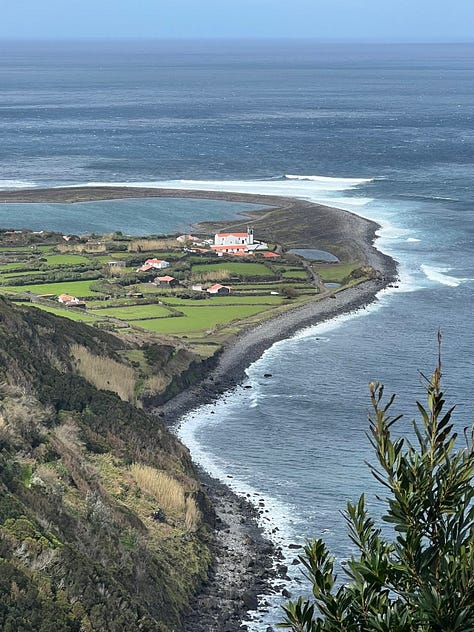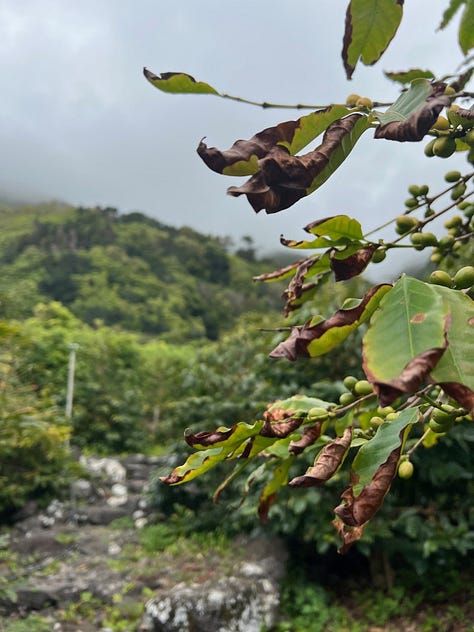Letters to Strangers: To the daughter of a family-owned café in São Jorge —
March 18, 2023: São Jorge Island
São Jorge is one of the nine volcanic islands that make up the Azores archipelago off mainland Portugal, and part of “The Triangle” with neighbors Pico and Faial islands. It is unusually long and thin, with a population under ten thousand, and near the south end of the string bean lies one of the only coffee shops on the entire island: Café Nunes.
We drove down a foggy, perilous loop to Fajã Dos Vimes and parked in the dirt lot facing the Atlantic Ocean, a sight that warred with the smell of manure and gloom of spring. Unassuming in its traditional Azorean design — whitewashed walls with volcanic stone accents, red-tiled Mediterranean roof — Café Nunes is dark and empty during the trough of tourist season. Ringing the bell at the front summons a bustling middle-aged woman, the bar matron and your mother; the lights flickered on and revealed walls plastered with a menagerie of foreign currency, signed by the hundreds of tourists that came before us.
Upon downing a cappuccino, we followed your mother to see what Café Nunes is famous for — the 500+ coffee plants that supply the café, before they have been plucked, dried, manually ground, and roasted in small batches. As we walk past multiple vegetable plants, a chicken coop, and various roaming animals and family members, it dawns on me that we’re headed to the rows of thick shrubs that stretch into the mountain above. It’s hard to reconcile what they are at first, round green nubs blending into the leaves, but noticing one materializes millions of other maturing beans, some already flushing with ripeness.
Your mother then took us into her loom room, where she sold handwoven bags and quilted bedspreads, a texture unique to the island. That’s where we met you, a thin, elegant woman speaking fluent English, and daughter of the Nunes family. You helped out with the café business when you could, but had left to mainland Portugal for your college years. You moved back to São Jorge to be with your childhood sweetheart, startled by the reverse culture shock and amused by the stickiness of tradition here. Most businesses here, for example, never attempted to adopt credit card payments. In a society fermenting in decades of tradition with little inflow and massive outflow, change moves at an agonizing rate. Is that why you left?
You were so curious about our American backgrounds — your cousins who grew up in the States live faster, wildly different lives than yours. But they don’t speak Portuguese. You understood America was a melting pot, a place where one can’t help but melt into. And while you laughed at the doggedness of the local Azoreans, there is no doubt familiarity, comfort, and duty in returning. Here, all secrets were publicly traded stories, but people trusted each other. Is that why you returned?
You now run your own hiking business, in the spirit of travel entrepreneurism that permeates the family, the island, and its unique fajãs — coastal plateaus formed from lava flows and landslides. Centuries of natural disasters — earthquakes, floods, and volcano eruptions — caused mass emigration but, still, villages sprang up on the fajãs. People realized the volcanic debris created fertile soil ideal for planting staples like coffee, yams, and maize, while the distinctive scenery began to attract visitors in swarms. It may take centuries, but the Azores islands evolved in their own quiet way, one that moves in harmony with the direction the fog drifts and the trees sway.
You’ve gazed across the ocean only to turn back; you speak in your mother tongue that is still your major tongue. You’ve married your childhood sweetheart, and you’ve inherited your childhood business. Though tempted by other winds, you chose known soils, where clear blue waves gently lap into fajãs, smooth and flat as poured batter. Perhaps because you sense that, over centuries to come, those waves will also carve grand arches into the volcanic cliffs of São Jorge.



My inspiration for this series, Letters to Strangers, comes from the compilation of the same name by Colleen Kinder. She writes:
“We spend so much of our lives in the company of people whose names we’ll never know, people we’ll never meet again. How rarely we honor them. How rarely we admit to ourselves the strange, unannounced ways they can lodge inside of us.
These essays don’t say, I knew you. They say, I never really knew you. They confess their own partial gazes. They open up territories we didn’t know we had inside of us. They offer themselves as vessels for our least official ghosts.”
Memory is imperfect, romantic, and often a reflection of ourselves. Writing letters to strangers allows me to embrace this semi-reality.

